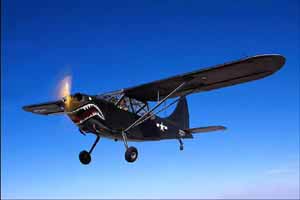Stinson L-5 Sentinel
U. S. Liaison, Observation & Ambulance
 |
One of the Ghost Squadron's L-5s. Image source: The Confederate Air Force Ghost Squadron CD-ROM produced by Corel. Photos by Bill Crump. |
The Stinson L-5 was probably the most successful US liaison aircraft of World War II, serving in both the European and Pacific theaters from 1943 thru 1945. It also saw action during the Korean War. The L-5’s ability to operate from unprepared fields and strips, sometimes as short as 300 feet, often meant that it was the only way to reach an area with orders or to evacuate wounded.
Developed from the Stinson Model 105 Voyager, a light three-seat civilian plane, the L-5 used a more powerful Lycoming O-435 flat six-cylinder, air-cooled engine, rated at 185 hp. The fuselage was constructed of a tubular steel frame, covered by fabric, while the wing was of wood construction, also fabric covered.
Over 3,000 L-5s were built during World War II. Most were the L-5 or L-5A observer model, while 679 of the L-5B ambulance model were produced. The L-5C had provision for a K-20 reconnaissance camera, and the L-5E added drooping ailerons which operated in conjunction with the flaps to increase lift for even shorter landings and takeoffs. The final production version was the L-5G, which featured a slightly different engine version of 190 hp.
The US Navy and Marines also used Sentinels, designating them OY-1s and 2s. The British Royal Air Force (RAF) also used some L-5 and L-5As, calling them Sentinel Mark Is and IIs.
Specifications
| One Pilot plus Observer
One Lycoming O-435 Engine Max. Speed 130 mph |
Length 24' 1" Max. Weight 2020 lbs Normal Range 420 miles |